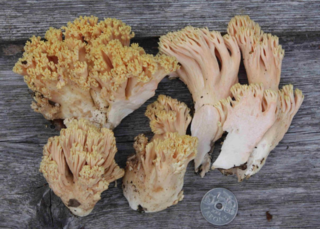
Ramaria formosa, commonly known as the salmon coral, beautiful clavaria, handsome clavaria, yellow-tipped- or pink coral fungus, is a coral fungus found in Europe. It is widely held to be mildly poisonous if consumed, giving rise to acute gastrointestinal symptoms of nausea, vomiting, diarrhea and colicky pain. It is a pinkish, much-branched coral-shape reaching some 20 cm (8 in) high. Similar forms collected in North America are now considered to represent a different species than the European Ramaria formosa.

The genus Ramaria comprises approximately 200 species of coral fungi. Several, such as Ramaria flava, are edible and picked in Europe, though they are easily confused with several mildly poisonous species capable of causing nausea, vomiting, and diarrhea; these include R. formosa and R. pallida. Three Ramaria species have been demonstrated to contain a very unusual organoarsenic compound homoarsenocholine.

Clavulina cristata, commonly known as the white coral fungus or the crested coral fungus, is a white- or light-colored edible coral mushroom present in temperate areas of the Americas and Europe. It is the type species of the genus Clavulina.

Ramaria flava, is a yellow coral mushroom found in Europe. Also known by its local name changle it is also native to temperate areas of southern Chile and south of Brazil.

Ramaria botrytis, commonly known as the clustered coral, the pink-tipped coral mushroom, or the cauliflower coral, is an edible species of coral fungus in the family Gomphaceae. Its robust fruit body can grow up to 15 cm (6 in) in diameter and 20 cm (8 in) tall, and resembles some marine coral. Its dense branches, which originate from a stout, massive base, are swollen at the tips and divided into several small branchlets. The branches are initially whitish but age to buff or tan, with tips that are pink to reddish. The flesh is thick and white. The spores, yellowish in deposit, are ellipsoid, feature longitudinal striations, and measure about 13.8 by 4.7 micrometers.

The clavarioid fungi are a group of fungi in the Basidiomycota typically having erect, simple or branched basidiocarps that are formed on the ground, on decaying vegetation, or on dead wood. They are colloquially called club fungi and coral fungi.

Ramaria acrisiccescens, commonly known as the blah coral, is a coral fungus in the family Gomphaceae. It is found in the forests of northwestern North America.

Ramaria fennica, commonly known as the bitter coral, is a coral mushroom in the family Gomphaceae. It is found in Australia, Europe and North America.

Ramaria stricta, commonly known as the strict-branch coral is a coral fungus of the genus Ramaria. It has a cosmopolitan distribution, and grows on dead wood, stumps, trunks, and branches of both deciduous and coniferous trees. Its fruit body is up to 10 cm tall, made of multiple slender, compact, and vertical parallel branches. Its color is typically light tan to vinaceous-brown. All parts of the mushroom will bruise when handled. There are several lookalike corals that can usually be distinguished from R. stricta by differences in coloration, bruising reaction, or microscopic features. The fungus is inedible due to its unpleasant odor and bitter taste.

Ramaria rasilispora, commonly known as the yellow coral, is a coral mushroom in the family Gomphaceae. Described as new to science in 1974, it is found in western North America south to Mexico, and in the eastern Himalaya.

Ramaria araiospora, commonly known as the red coral, is a coral mushroom in the family Gomphaceae. First described in 1974, it is found in North America, and the Himalaya. An edible species, it is sold in local markets in Mexico.
Ramaria conjunctipes is a coral mushroom in the family Gomphaceae. It is found in North America and Thailand.

Ramaria sanguinea, commonly known as the bleeding coral or the bloody coral, is a coral mushroom in the family Gomphaceae.

Ramaria rubrievanescens, commonly known as the fading pink coral, is a coral mushroom in the family Gomphaceae. It is found in North America.

Ramaria rubripermanens is a species of coral fungus in the family Gomphaceae. Described as new to science in 1973, it is found in the western United States and Mexico. Its fruit bodies, which resemble sea coral, grow up to 16 cm (6.3 in) tall and feature whitish to light yellow branches with pinkish to reddish tips. It is edible.

Ramaria rielii is a European species of coral fungus in the family Gomphaceae. It was described in 1897 by Jean Louis Émile Boudier. It is quite similar in appearance to the more common and widely distributed Ramaria botrytis, but can be distinguished from that species by the lack of clamped hyphae, its longer and wider spores, and warts instead of striations on the spore surface.

Ramaria magnipes is a coral fungus in the family Gomphaceae. It is found in western North America, where it fruits on the ground in mixed forests.

Ramaria rubiginosa is a coral mushroom in the family Gomphaceae. It is found in North America.

Ramaria gracilis is a species of coral fungus in the family Gomphaceae.

Ramaria myceliosa is a species of coral fungus in the family Gomphaceae. Found in North America, it was originally described by Charles Horton Peck in 1904 with the name Clavaria myceliosa. The type was collected by botanist Edwin Bingham Copeland in the mountains near Stanford University in California. E.J.H. Corner transferred it to the genus Ramaria in 1950. Giachini and colleagues proposed that Ramaria myceliosa is the same species as the European Phaeoclavulina curta, but did not provide molecular evidence to support their suggested synonymy. In a recent (2014) publication on California fungi, the authors propose the transfer of Ramaria myceliosa to the genus Phaeoclavulina, but as of January 2016, this transfer has not been accepted by either MycoBank or Index Fungorum.



















